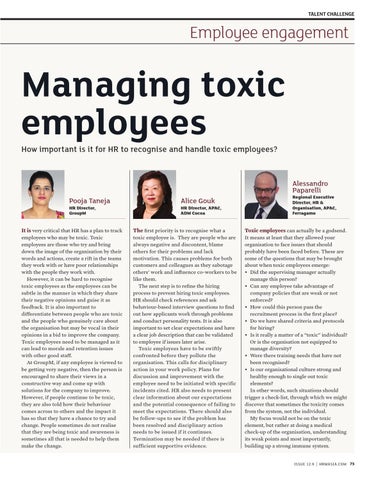TALENT CHALLENGE
Employee engagement
Managing toxic employees How important is it for HR to recognise and handle toxic employees?
Alessandro Paparelli Pooja Taneja HR Director, GroupM
It is very critical that HR has a plan to track employees who may be toxic. Toxic employees are those who try and bring down the image of the organisation by their words and actions, create a rift in the teams they work with or have poor relationships with the people they work with. However, it can be hard to recognise toxic employees as the employees can be subtle in the manner in which they share their negative opinions and guise it as feedback. It is also important to differentiate between people who are toxic and the people who genuinely care about the organisation but may be vocal in their opinions in a bid to improve the company. Toxic employees need to be managed as it can lead to morale and retention issues with other good staff. At GroupM, if any employee is viewed to be getting very negative, then the person is encouraged to share their views in a constructive way and come up with solutions for the company to improve. However, if people continue to be toxic, they are also told how their behaviour comes across to others and the impact it has so that they have a chance to try and change. People sometimes do not realise that they are being toxic and awareness is sometimes all that is needed to help them make the change.
Alice Gouk
HR Director, APAC, ADM Cocoa
The first priority is to recognise what a toxic employee is. They are people who are always negative and discontent, blame others for their problems and lack motivation. This causes problems for both customers and colleagues as they sabotage others’ work and influence co-workers to be like them. The next step is to refine the hiring process to prevent hiring toxic employees. HR should check references and ask behaviour-based interview questions to find out how applicants work through problems and conduct personality tests. It is also important to set clear expectations and have a clear job description that can be validated to employee if issues later arise. Toxic employees have to be swiftly confronted before they pollute the organisation. This calls for disciplinary action in your work policy. Plans for discussion and improvement with the employee need to be initiated with specific incidents cited. HR also needs to present clear information about our expectations and the potential consequence of failing to meet the expectations. There should also be follow-ups to see if the problem has been resolved and disciplinary action needs to be issued if it continues. Termination may be needed if there is sufficient supportive evidence.
Regional Executive Director, HR & Organisation, APAC, Ferragamo
Toxic employees can actually be a godsend. It means at least that they allowed your organisation to face issues that should probably have been faced before. These are some of the questions that may be brought about when toxic employees emerge: • Did the supervising manager actually manage this person? • Can any employee take advantage of company policies that are weak or not enforced? • How could this person pass the recruitment process in the first place? • Do we have shared criteria and protocols for hiring? • Is it really a matter of a “toxic” individual? Or is the organisation not equipped to manage diversity? • Were there training needs that have not been recognised? • Is our organisational culture strong and healthy enough to single out toxic elements? In other words, such situations should trigger a check-list, through which we might discover that sometimes the toxicity comes from the system, not the individual. My focus would not be on the toxic element, but rather at doing a medical check-up of the organisation, understanding its weak points and most importantly, building up a strong immune system. ISSUE 12.9
HRMASIA.COM 75
